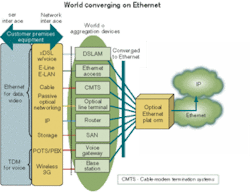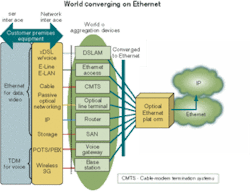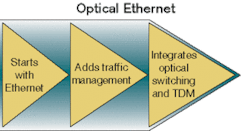RPR and optical Ethernet vie for metro-network supremacy
However, Ethernet was not initially designed for carrier networks. Enterprise class Ethernet faces many challenges in meeting several fundamental carrier requirements. For example, carriers need to sell services with defined service-level agreements (SLAs), which include parameters such as committed bandwidth, maximum burst bandwidth, delay, and jitter limits. Enterprise class Ethernet can only limit bandwidth to the speed of the port (10 Mbits/sec, 100 Mbits/sec, 1 Gbit/sec, or 10 Gbits/sec).
Similarly, carriers have stringent protection requirements. Service must be automatically restored after any equipment or fiber failures—often within 50 msec. Enterprises typically do not have such stringent protection requirements, if they have any protection requirements at all. The only mechanism offered by enterprise class Ethernet for such protection is spanning tree protocol, which has several deficiencies, including very long convergence times and the fact that redundant links cannot be used during normal operation.
In addition, carriers deploying services to businesses are required to provide not only Ethernet services, but also TDM interfaces such as E1/T1 to support applications like PBX private networks, PSTN access, and legacy router connectivity. Enterprise class Ethernet does not provide the mechanisms or quality of service guarantees required to provide TDM interfaces in a manner that is TDM standards-compliant. And while the typical Ethernet network topology in an enterprise is a tree, carriers require other topologies, including rings and mesh. Enterprise class Ethernet does not support these topologies, particularly because there cannot be loops in the Layer 2 network.
Finally, carriers require simple and effective mechanisms for provisioning services and, once they are provisioned, the ability to monitor their status and conformance to the SLA sold to the customer.
To meet these carrier needs, two approaches have evolved. One is resilient packet ring (RPR) and the other is optical Ethernet (OpE). While both aim to resolve these issues and provide carriers with profitable MAN services, there are significant differences between them.
RPR is based on a new IEEE standard for high-speed data access. This standard, IEEE 802.17, allows deterministic network behavior by changing the basic Ethernet behavior and frame format.
RPR is a ring technology and operates only in ring topologies using concepts borrowed from SONET and SDH. In RPR, end users are connected to RPR devices, which act similarly to add/drop multiplexers. In each node, traffic is either in-transit (transported unchanged to the next node), dropped (sent to the end user), or added (sent from the end user back on the ring).
RPR is a Layer 2 technology that can utilize either Ethernet or SONET/SDH as the transport medium. In practice, however, almost all the deployments of RPR have used SONET/SDH transport.
RPR represents an improvement over both SONET/SDH and enterprise class Ethernet. RPR handles bursty data traffic better than SONET/SDH and does not suffer from the same service granularity issues as TDM technologies. Because RPR is an access technology, end-to-end behavior depends on the capabilities of the equipment in the edge and core of the network.
When compared to enterprise class Ethernet, RPR addresses the above-mentioned carrier class requirements. To support SLAs, for example, RPR implements a deterministic yet shared medium, in which the bandwidth available to each node in the access ring is known. Thus in the access ring, services can be provisioned with committed bandwidth. In the rest of the network, however, other mechanisms need to be used, if they are available.
RPR implements "ring wrap" and "steering" mechanisms to achieve 50-msec protection against fiber cuts and equipment failures in the access ring. Bandwidth reserved for protection can be used for best-effort traffic during normal operation. For protection against failures anywhere else in the network, the protection mechanisms of the edge and core technology must be used.
Since RPR can travel over SONET/SDH, it naturally enables integration of legacy TDM services such as E1/T1 and DS-3 in the access ring where RPR provides fundamental elements for provisioning and monitoring. Each node is aware of the bandwidth available in the ring, so provisioning can be achieved by accessing only the nodes at which traffic begins and ends. Similarly, SLA monitoring can be achieved at the endpoints of the service. In other areas of the network, however, service provisioning must be done using the existing mechanisms of the technology used.
RPR currently is used most frequently to extend the life of existing SONET/SDH networks by upgrading the access rings to a data-optimized technology. In its most popular incarnation, RPR rides on SONET/SDH transport, integrates well with SONET/SDH edge and core equipment, and carries both TDM and packet data traffic in the access ring.
But in addition to operating only in a ring topology, RPR has other limitations. Many metro networks demand combinations of ring, mesh, and tree topologies to fit practical deployment requirements. Because of RPR's ring topology, any increase in bandwidth requirements between any two nodes on a ring dictates a bandwidth upgrade for the entire ring. RPR's protection mechanism resides at the network level. The lack of protection granularity for individual services or users results in an unnecessary waste of network resources and a decrease in the levels of services being offered. (RPR protection mechanisms become redundant in implementations over SONET/SDH, which has its own 50-msec protection mechanism.) In addition, IEEE 802.17 doesn't define a protection mechanism beyond a ring, which makes 50-msec protection confined in one ring only.
The optical Ethernet approach is different from RPR in that it uses standard Ethernet alone or in combination with MPLS to address the carrier class requirements (see Figure 2). To achieve SLAs, for example, OpE uses a combination of connection admission control (which is similar to the call admission control of ATM), policing, congestion control with drop precedence, and multiple traffic priorities.In the connection-oriented paradigm of OpE, services are pre-provisioned as connections (similar to ATM virtual circuits). Services are defined as having an end-to-end SLA, consisting of committed information rate (CIR), peak information rate (PIR—best-effort burst), delay, and jitter. The routes of the service in the network are determined based on available bandwidth. Connection admission control ensures that CIR is never overbooked (unless the operator has an overbooking policy), and SLAs are therefore always guaranteed. Traffic is policed at ingress to ensure it never exceeds the PIR defined in the SLA. When congestion occurs, traffic over and above the CIR level is dropped.
Optical Ethernet achieves protection via a mechanism known as "fast reroute," in which a link or equipment failure triggers a change in the route of the network to pre-provisioned secondary paths. This approach can restore failures in under 50 msec, regardless of where in the network the failure has taken place. Moreover, bandwidth reserved for these protection mechanisms can be used during normal operation for best-effort unprotected traffic such as Internet access.
OpE enables legacy integration by combining the SLA guarantees described above with a technology known as circuit emulation services, which allows TDM services such as E1/T1, E3/DS-3, and STM-1/OC-3 to be carried over Ethernet in a fully standard manner.
Since optical Ethernet is connection-oriented, there is no such thing as a loop. Thus, OpE networks can be designed in any topology, including ring, star, tree or mesh.
Optical Ethernet includes many mechanisms that facilitate the provisioning of services and monitoring of their status. A network management system typically performs OpE service provisioning. Optical Ethernet defines algorithms for optimal routing through the network based on resource availability. More important, OpE defines operations, administration, and management protocols that allow services to be monitored for connectivity, actual throughput, packet loss, delay, and jitter.
With OpE, the Ethernet frame format is unchanged. Rather than changing Ethernet, OpE makes use of Ethernet as well as standard MPLS to implement the mechanisms required to provide the above capabilities. By using standard Ethernet, OpE products can leverage the huge number of Ethernet devices sold each year, reducing costs by using the resulting low-cost components.Optical Ethernet is an end-to-end technology for the metro (see Figure 3). The benefits of OpE do not end at the metro access but continue through the metro core, right up to the other end of the service. Service-level agreements are provisioned and monitored end-to-end. Protection is everywhere in the network. All topologies are possible. Therefore, optical Ethernet is a complete end-to-end solution for next-generation MANs.
Gadi Solomon is director of product management at Atrica (Santa Clara, CA).



